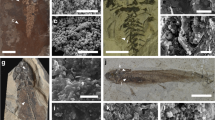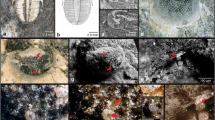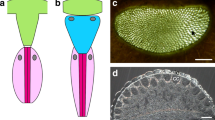Abstract
Tullimonstrum gregarium is an iconic soft-bodied fossil from the Carboniferous Mazon Creek Lagerstätte (Illinois, USA)1. Despite a large number of specimens and distinct anatomy, various analyses over the past five decades have failed to determine the phylogenetic affinities of the ‘Tully monster’, and although it has been allied to such disparate phyla as the Mollusca2, Annelida3,4 or Chordata5, it remains enigmatic1,2,3,4,5. The nature and phylogenetic affinities of Tullimonstrum have defied confident systematic placement because none of its preserved anatomy provides unequivocal evidence of homology, without which comparative analysis fails. Here we show that the eyes of Tullimonstrum possess ultrastructural details indicating homology with vertebrate eyes. Anatomical analysis using scanning electron microscopy reveals that the eyes of Tullimonstrum preserve a retina defined by a thick sheet comprising distinct layers of spheroidal and cylindrical melanosomes. Time-of-flight secondary ion mass spectrometry and multivariate statistics provide further evidence that these microbodies are melanosomes. A range of animals have melanin in their eyes, but the possession of melanosomes of two distinct morphologies arranged in layers, forming retinal pigment epithelium, is a synapomorphy of vertebrates. Our analysis indicates that in addition to evidence of colour patterning6, ecology7 and thermoregulation8, fossil melanosomes can also carry a phylogenetic signal. Identification in Tullimonstrum of spheroidal and cylindrical melanosomes forming the remains of retinal pigment epithelium indicates that it is a vertebrate; considering its body parts in this new light suggests it was an anatomically unusual member of total group Vertebrata.
This is a preview of subscription content, access via your institution
Access options
Subscribe to this journal
Receive 51 print issues and online access
$199.00 per year
only $3.90 per issue
Buy this article
- Purchase on Springer Link
- Instant access to full article PDF
Prices may be subject to local taxes which are calculated during checkout




Similar content being viewed by others
References
Richardson, E. S. Jr. Wormlike fossil from the Pennsylvanian of Illinois. Science 151, 75–76 (1966)
Foster, M. in Mazon Creek Fossils (ed. Nitecki, M. H. ) 269–301 (Academic, 1979)
Johnson, R. G. & Richardson, E. S. Pennsylvanian invertebrates of the Mazon Creek Area, Illinois: the morphology and affinities of Tullimonstrum . Fieldiana Geol. 12, 119–149 (1969)
Schram, F. in The Early Evolution of Metazoa and The Significance of Problematic Taxa (eds Conway-Morris, S. & Simonetta, A. M. ) 35–46 (Cambridge Univ. Press, 1991)
Beall, B. in The Early Evolution of Metazoa and The Significance of Problematic Taxa (eds Conway-Morris, S. & Simonetta, A. M. ) 271–286 (Cambridge Univ. Press, 1991)
Vinther, J., Briggs, D. E., Prum, R. O. & Saranathan, V. The colour of fossil feathers. Biol. Lett. 4, 522–525 (2008)
Clarke, J. A. et al. Fossil evidence for evolution of the shape and color of penguin feathers. Science 330, 954–957 (2010)
Lindgren, J. et al. Skin pigmentation provides evidence of convergent melanism in extinct marine reptiles. Nature 506, 484–488 (2014)
Donoghue, P. C. & Purnell, M. A. Distinguishing heat from light in debate over controversial fossils. BioEssays 31, 178–189 (2009)
Rieppel, O. & Kearney, M. Similarity. Biol. J. Linn. Soc. 75, 59–82 (2002)
Ruppert, E. E. Key characters uniting hemichordates and chordates: homologies or homoplasies? Can. J. Zool. 83, 8–23 (2005)
Colleary, C. et al. Chemical, experimental, and morphological evidence for diagenetically altered melanin in exceptionally preserved fossils. Proc. Natl Acad. Sci. USA 112, 12592–12597 (2015)
Kluessendorf, J. & Doyle, P. Pohlsepia mazonensis, an early ‘octopus’ from the Carboniferous of Illinois, USA. Palaeontology 43, 919–926 (2000)
Bardack, D. First fossil hagfish (Myxinoidea): a record from the Pennsylvanian of Illinois. Science 254, 701–703 (1991)
Bardack, D. & Zangerl, R. First fossil lamprey: a record from the Pennsylvanian of Illinois. Science 162, 1265–1267 (1968)
Sallan, L. C. & Coates, M. I. The long-rostrumed elasmobranch Bandringa zangerl, 1969, and taphonomy within a Carboniferous shark nursery. J. Vertebr. Paleontol. 34, 22–33 (2014)
Shabica, C. W. & Hay, A. Richardson’s Guide to The Fossil Fauna of Mazon Creek (eds Shabica, C. W. & Hay, A. H. ) (Northeastern Illinois Univ., 1997)
Sansom, R. S., Gabbott, S. E. & Purnell, M. A. Decay of vertebrate characters in hagfish and lamprey (Cyclostomata) and the implications for the vertebrate fossil record. Proc. R. Soc. B 278, 1150–1157 (2011)
Sansom, R. S., Gabbott, S. E. & Purnell, M. A. Atlas of vertebrate decay: a visual and taphonomic guide to fossil interpretation. Palaeontology 56, 457–474 (2013)
Fein, A. & Szuts, E. Z. Photoreceptors, Their Role in Vision Vol. 5 (Cambridge Univ. Press, 1982)
Vopalensky, P. & Kozmik, Z. Eye evolution: common use and independent recruitment of genetic components. Phil. Trans. R. Soc. B 364, 2819–2832 (2009)
Hase, S. et al. Characterization of the pigment produced by the planarian, Dugesia ryukyuensis. Pigment Cell Res. 19, 248–249 (2006)
Kozmik, Z. et al. Assembly of the cnidarian camera-type eye from vertebrate-like components. Proc. Natl Acad. Sci. USA 105, 8989–8993 (2008)
Sato, S. & Yamamoto, H. Development of pigment cells in the brain of ascidian tadpole larvae: insights into the origins of vertebrate pigment cells. Pigment Cell Res. 14, 428–436 (2001)
Speiser, D. I., DeMartini, D. G. & Oakley, T. H. The shell-eyes of the chiton Acanthopleura granulata (Mollusca, Polyplacophora) use pheomelanin as a screening pigment. J. Nat. Hist. 48, 2899–2911 (2014)
Liu, Y. et al. Comparisons of the structural and chemical properties of melanosomes isolated from retinal pigment epithelium, iris and choroid of newborn and mature bovine eyes. Photochem. Photobiol. 81, 510–516 (2005)
Bardack, D. & Richardson, E. Jr. New agnathous fishes from the Pennsylvanian of Illinois. Fieldiana Geol. 33, 489–510 (1977)
Weihs, D. & Moser, H. Stalked eyes as an adaptation towards more efficient foraging in marine fish larvae. Bull. Mar. Sci. 31, 31–36 (1981)
Haacke, C., Hess, M., Melzer, R. R., Gebhart, H. & Smola, U. Fine structure and development of the retina of the grenadier anchovy Coilia nasus (Engraulididae, Clupeiformes). J. Morphol. 248, 41–55 (2001)
Wagner, M. S., Graham, D. J., Ratner, B. D. & Castner, D. G. Maximizing information obtained from secondary ion mass spectra of organic thin films using multivariate analysis. Surf. Sci. 570, 78–97 (2004)
Acknowledgements
W. Simpson, P. Mayer, S. Williams, D. Rudkin and K. Seymour are thanked for specimen access and loans. Funding was through a Natural Environment Research Council studentship P14DF19 (to T.C.) and grant NE/K004557/1 (to M.A.P. and S.E.G.). We also acknowledge the National Science Foundation grant DMR-0923096 used to purchase the TOF–SIMS instrument at Texas Materials Institute, UTA. D. Murdock, C. Nedza, S. Wentges and A. Clements are thanked for proofreading. S. Furzeland is thanked for scanning electron microscope optimization. P. Smith is thanked for Adobe Illustrator tutorials.
Author information
Authors and Affiliations
Contributions
S.E.G. and M.A.P. conceived the research programme of which this work is part. S.E.G., J.V. and T.C. designed and performed research. S.E.G., T.C., J.V., M.A.P. and A.D. wrote the manuscript. A.D. and J.V. undertook TOF–SIM analyses and interpretation. J.V., A.D. and M.A.P. conducted PCA. S.E.G., T.C., J.V. and P.M. operated and optimized the scanning electron microscope.
Corresponding authors
Ethics declarations
Competing interests
The authors declare no competing financial interests.
Extended data figures and tables
Extended Data Figure 1 Details of T. gregarium eyes.
a, Complete specimen (MCPX27C5369, Burpee Museum of Natural History) with eyes (ey). Scale bar: 10 mm. b, Close-up of the uppermost eye in a, showing dark carbonaceous material and an approximately centrally positioned white circular area with high relief. The white mineral is kaolinite. This is similar to the eye in Bandringa (Extended Data Fig. 6) and the white infilling of kaolinite may be indicative of a lens16. Scale bar, 1 mm. c–l, Specimen PE22126 (Field Museum of Natural History). c, Complete specimen in nodule showing clearly defined eyes (ey) and transverse bar (tb). Scale bar, 10 mm. d, The uppermost eye in c. Scale bar: 1 mm. e–l, Scanning electron microscope images of the eye ultrastructure. e, Oblate melanosomes on the left-hand side and underlying cylindrical melanosomes on the right-hand side. f–h, Higher magnification images of the centre of e; in g, oblate melanosomes are highlighted in blue, and h is an anaglyph (three-dimensional) image of the same field of view as f and g (see also Fig. 2). i, Anaglyph (three-dimensional) image showing oblate melanosomes overlying cylindrical melanosomes. j, Oblate and cylindrical melanosomes in distinct layers. k, l, The cylindrical and oblate melanosome morphologies, respectively. Scale bars, 2 μm.
Extended Data Figure 2 Tullimonstrum (BMRP2014MCP1000) with scanning electron microscope images of anatomical features.
a, Complete specimen (anterior at top) with scanning electron microscope images showing the mode of preservation of the anatomy and that only the eyes contain melanosomes. Scale bar, 10 mm. b, Proboscis with small, dark, organic carbon patch (oC) which has a smooth texture. c, Distal portion of the proboscis ‘claw’ showing pyrite crystals and framboids. d, Eye bar containing siderite and clay minerals. e, Eye showing melanosome texture. f, Dark transverse banding (possible myomeres) containing mainly siderite. g, The nodule matrix: siderite and detrital clay minerals. h, Main trunk: siderite and clay minerals. oC, organic carbon; sd, siderite; py, pyrite. Scale bars, 2 μm.
Extended Data Figure 3 Negative ion TOF–SIMS spectra in the 45–100 and 100–175 atomic mass unit range.
Spectra for comparison with the Tullimonstrum eye melanosomes (BMRP2014MCP1000) are from an Eocene frog eye (Messel Lagerstätte), Jurassic ink sac from Lyme Regis (UK), extant glossy black carrion crow (C. corone) and a reddish brown domestic chicken (G. gallus). Comparative spectra are from ref. 12. Negative ion TOF–SIMS spectra in the 45–100 atomic mass unit range are shown in the left column and 100–175 atomic mass unit range in the right column. Melanin specific peaks are indicated by red crosses.
Extended Data Figure 4 PCA of TOF–SIMS spectra.
a, PCA plot of 55 negative secondary ion peaks12 from fresh, artificially matured (24 h at 200 °C/250 bar and 250 °C/250 bar) and fossil melanin samples as well as a variety of melanin-negative samples and Tullimonstrum eye (all listed in b). The two separately acquired spectra from regions of the eye in Tullimonstrum have similar relative intensity distributions of the melanin-specific peaks to other fossil melanosome samples, plotting near an Eocene frog eye and a lamprey eye from Mazon Creek. c, Eigenvector values for principal components 1 and 2. d, Eigenvalues for the first 12 principal components and the percentage of the variation accounted for by each. e, Loading plot showing the relative factor loadings onto PC axes 1 and 2. Fragments such as CnNH-, CnNO-, CnNS-, CnSH- and CnOH- are mostly responsible for the separation of fossil melanin in the PCA space, whereas fragments such as Cn- and CnH- separate the fresh melanin. This indicates both the chemical degradation (loss of carbon, nitrogen, sulfur and water) and structural degradation (weaker molecular bonding) of melanin during the fossilization process.
Extended Data Figure 5 Gnathostomes with dark eyes and eye ultrastructure from the Mazon Creek Lagerstätte.
a–c, Esconicthys apopyris (PF9831), a putative larval lungfish17. d–f, Elonichthys peltigerus (ROM56794). g–i, Platysomus circularis (PF7333). j–l, Bandringa rayi (ROM56789). Note the white centrally positioned circular feature in both eyes. The white mineral is kaolinite, which most probably reflects the position of the lens16. c, f, i, l, Backscattered scanning electron microscope images of the eyes from each corresponding fossil. Melanosomes of cylindrical and oblate morphologies are found in Esconicthys, Elonichthys and Platysomus; in Bandringa, only oblate melanosomes occur. Scale bars, 5 mm (b, e, h, k); 1 μm (c, f, i, l).
Extended Data Figure 6 TOF–SIMS intensity maps from eye region in Tullimonstrum, showing relative distribution of ions derived from melanin relative inorganic ions from the matrix.
False-colour chemical mapping of the spatial distribution of several melanin-specific secondary ion fragments (a, e, i, m, q, u) compared with the maps of melanin-characteristic ions (b, c, n, o) and inorganic ions derived from the sediment (SiOn-, j, w; Al(Hn)On−, k, v) and the concretion cements (FeO2−, g; CaSOH-, f), which map distinctly from the melanin ions or co-occur with melanin (PO2−, r; PO2H−, s). The secondary ion CHO2− is likely from carboxyl groups (o) and is a known constituent of melanin. It exhibits only a moderate overlap with melanin markers (p), which could be attributed to different diagenetic alterations of the melanin or some difference in composition. The right-hand column maps are composites of the tentatively assigned secondary ions in their respective row (that is, d is a composite of a–c). The distribution of inorganic and organic ions shows that the melanin and matrix ions are distinct contributions to the TOF–SIMS spectrum.
Supplementary information
Supplementary Information
This file contains Supplementary Text and Data and Supplementary References. (PDF 131 kb)
Rights and permissions
About this article
Cite this article
Clements, T., Dolocan, A., Martin, P. et al. The eyes of Tullimonstrum reveal a vertebrate affinity. Nature 532, 500–503 (2016). https://doi.org/10.1038/nature17647
Received:
Accepted:
Published:
Issue Date:
DOI: https://doi.org/10.1038/nature17647
This article is cited by
-
Variations in preservation of exceptional fossils within concretions
Swiss Journal of Palaeontology (2023)
-
Taphonomic experiments reveal authentic molecular signals for fossil melanins and verify preservation of phaeomelanin in fossils
Nature Communications (2023)
-
Genome-centric resolution of novel microbial lineages in an excavated Centrosaurus dinosaur fossil bone from the Late Cretaceous of North America
Environmental Microbiome (2020)
-
Hierarchical biota-level and taxonomic controls on the chemistry of fossil melanosomes revealed using synchrotron X-ray fluorescence
Scientific Reports (2020)
-
Fossil insect eyes shed light on trilobite optics and the arthropod pigment screen
Nature (2019)
Comments
By submitting a comment you agree to abide by our Terms and Community Guidelines. If you find something abusive or that does not comply with our terms or guidelines please flag it as inappropriate.



